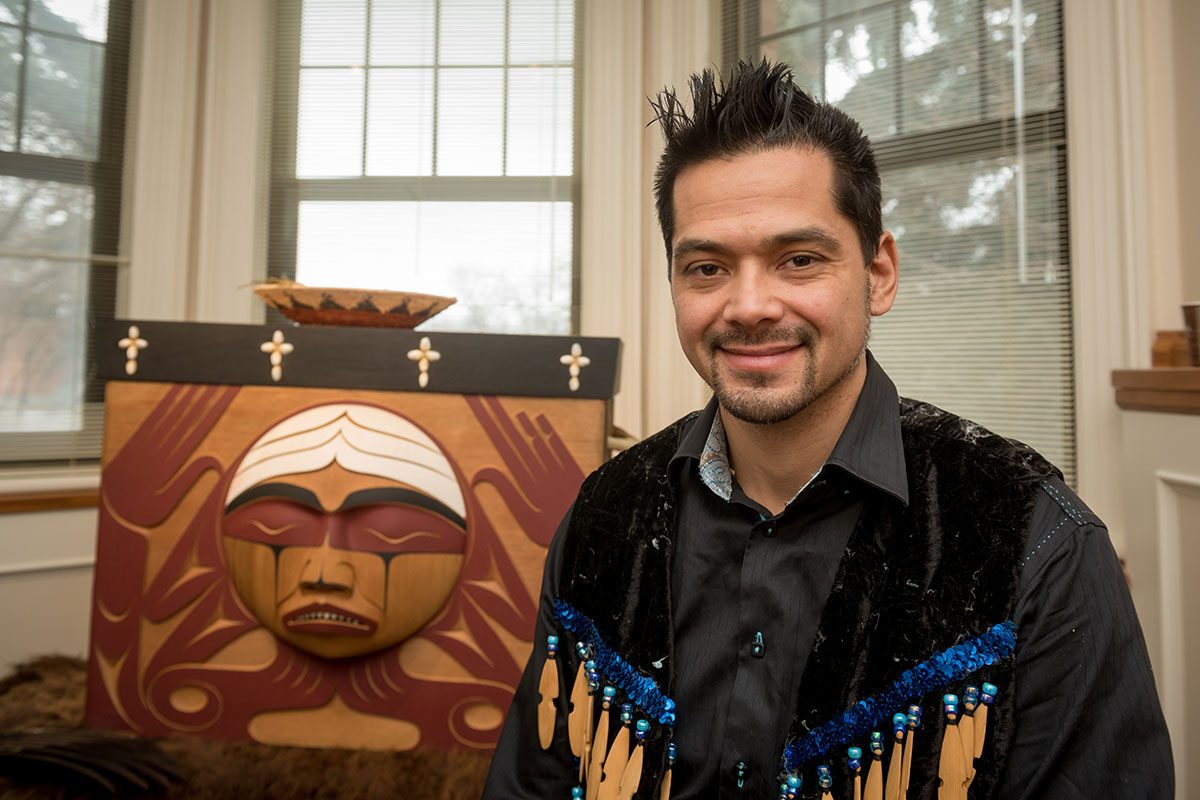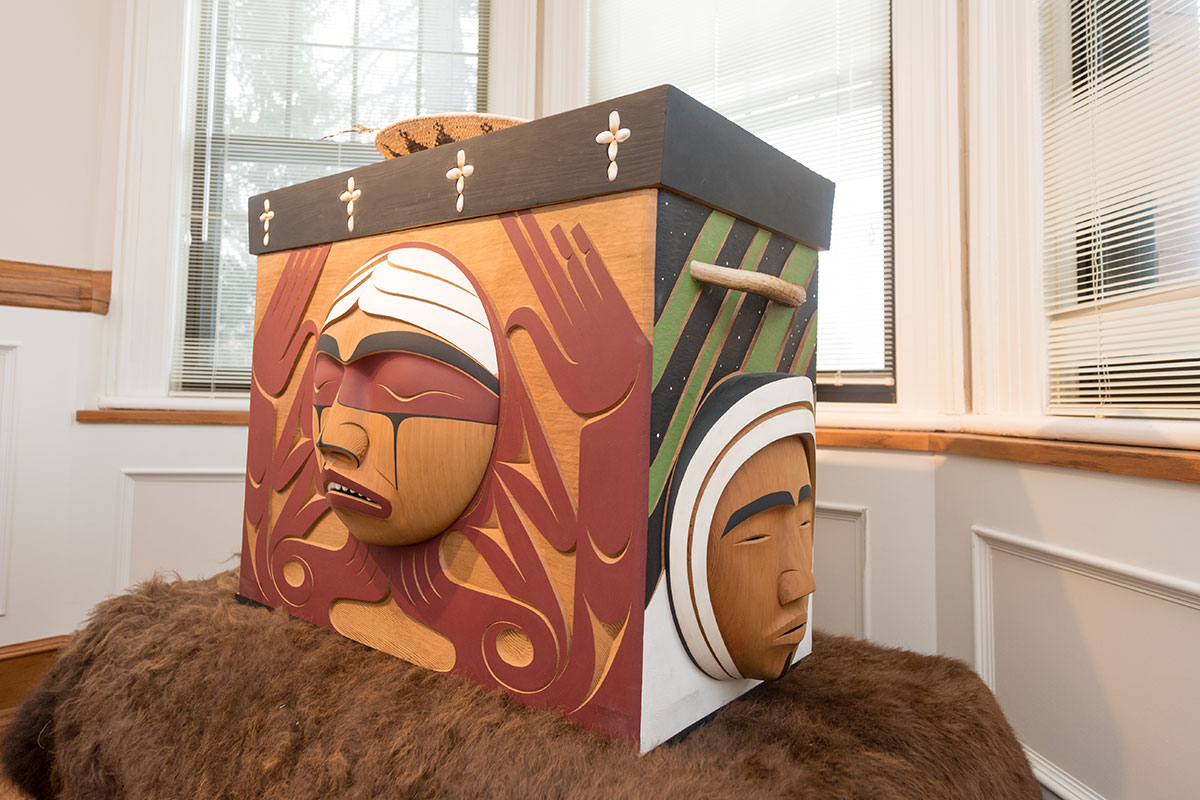
Coast Salish artist Luke Marston carved the Truth and Reconciliation Commission of Canada's Bentwood Box.
Q&A with TRC Bentwood Box artist Luke Marston
After a long journey of healing, the Truth and Reconciliation Commission of Canada (TRC)’s Bentwood Box has finally made it home.
Commissioned in 2009, the Box spent years traveling the country with the TRC, collecting items from Residential School Survivors relating to their personal journeys. More recently, the Box was featured at the Canadian Museum for Human Rights in an exhibit on Truth and Reconciliation.
On Jan. 25, Residential School Survivors, Indigenous Elders and the Box’s carver, Coast Salish artist Luke Marston, came together to welcome the Box to its new permanent residence at the National Centre for Truth and Reconciliation at the University of Manitoba, where it will continue to be a symbol of hope.
UM Today sat down with Marston to learn about the significance of the Bentwood Box.
UM Today: What was your inspiration for the design of the Bentwood Box?
The inspiration for the healing box, or the TRC Bentwood Box, came from my family: my grandmother and my grandmother’s mother were in Residential Schools, both in Kuper Island [British Columbia], so I drew inspiration from that. I also have other relatives – friends of the family, mentors, Elders – who were in Residential Schools who really helped me when I was making the Box, through guidance and things like that.
Then also, it had to have the representation of all the Nations across Canada, so not just where I’m from – the West Coast – but also the Woodlands First Nations and the more northern Inuit territories and the Métis people as well had to be represented on the Box. Looking within their culture, I found inspiration through their art forms as well.
Can you tell me about the traditional steam Bentwood Box and the materials you used for this particular piece?
The steam Bentwood Box is a traditional form that was used down to Seattle and all the way up north into the Tsimshian territory. We use them for collecting and storing food and storing things like masks and blankets and anything for cooking. They would be water tight so you could put water in them then put rocks in them to boil food. They’re also used for holding medicine, which this particular one is.
The whole Box is made out of western red cedar. It’s old growth wood. We believe that when we cut down one of those old growth trees, or any tree, we give it a new life into something else. It’s still a living thing, it still has its own spirit, or its own soul, even when it’s just a piece of wood. So that’s why we believe our houses and stuff – like the cedar houses – are still living. We name our houses and our masks and things like that because all of those materials, that cedar, is a sacred thing to us, that’s why we use that traditional wood.
How does the Bentwood Box represent the identity of Canada?
When I look at the Box, I definitely think that I captured the First Nations of Canada distinctly from each area. There are so many different nations within Canada that it would be impossible to get every one, but when you think about Woodlands First Nations – I definitely captured their style of art form. The medicine circle is distinctive to this area and then the Métis figure eight is an iconic symbol that everybody knows. The Bentwood Box itself is for sure a West Coast Box, it comes from there, and that style of carving is Coast Salish, representing the North-West coast carvers. Then the Inuit, the more northern people, are represented with the northern lights and the Inuit man with his parka over his head. As a whole, I feel like it is representative of the Canadian First Nations people for sure.
Then also, when you look at it you can see what it represents, as Canada, and as Canadians, and what Canada has decided to do by acknowledging the Residential Schools and what’s happened. I think that’s the biggest thing when you think about, “Does it encompass Canada?” It’s like, well yeah, this is what Canadians are about and this is what we’re doing – we’re taking responsibility for what’s happened.
As Canada celebrates its 150th Birthday, how do you see the Bentwood Box playing into Canada’s future?
The thing with the Bentwood Box coming back here, I feel like it was a necessary move to have it still to be active. Having it safe in the [Canadian Museum for Human Rights] is one thing, but also to have it here, still being used by people and Survivors and knowing that they can come here – it’s something, you know. They say they collected 7,000 statements and they’re all in that Box, so you know if people want to come here and talk and still use the Box, I think that’s really necessary.
I don’t believe that the journey of the [Truth and Reconciliation Commission of Canada] is over, I don’t think that healing can be done that quickly – undo all this in five years – especially with the diversity of the people that were affected through the schools. I don’t really know what I see for the 150th for the Box, but I’m happy to see that it’s carrying on and still working and helping people to heal.

The TRC Bentwood Box in its new home at NCTR.







Dear Mr, Marsten;
I am privileged to see your wonderful Bentwood Box and learn of it’s story and it’s resting place. We need to continue learning about our indigenous brothers and sisters. I believe you/they, know best how to save Mother Earth